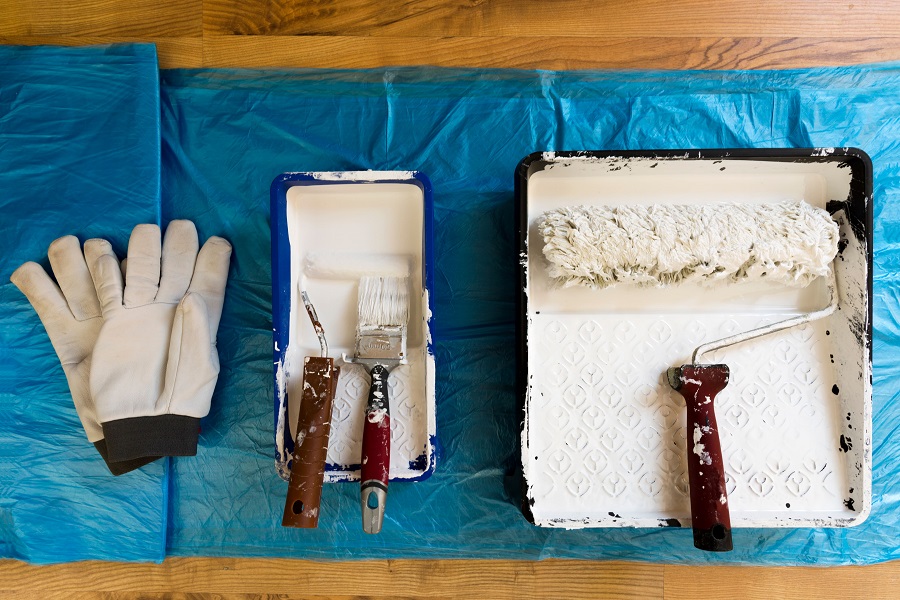Preparation Routine For Interior And Exterior Paint Jobs

Having a freshly painted home is not only beautiful but also enjoyable. If you are one of those people who doesn't want to repaint their home on their own, then you may have already started your search for a professional house painter. But finding a contractor or painting company is just the first step to completing your project. Now that you've decided to employ residential painting services, you may wonder what final work needs to be done before hiring a professional painting contractor.
To help you complete both interior and exterior painting projects smoothly, we have put together a list of ways to prepare for an all-in-one residential painting prep routine that will make your painting job more manageable and ensure your safety and satisfying paint results.
General Painting Preparation Routine
House Inspection
A home inspection is essential to keeping your home looking new and up to date. This is a crucial step when you own a home that can help your home keep its value if you're always interested in minor repair or painting projects. If your home is optimally protected against aging, even after being repainted, it should be inspected regularly by a professional. You may find the exterior of your home permanently damaged if your home exterior is not checked. On top of that, there is a good chance that the repair might require a large sum of money.
To ensure that your home is optimally protected, you should adhere to a yearly inspection before completing the exterior paint job. Before a paint job prep, an annual house inspection by professionals will help you. In addition, you will understand whether you should pressure wash once a year or use other techniques to scrape off the dirt, dust, and mould or make further repairs before you start your house paint preparation.
Professional Consultation
One of the first steps to getting your house ready for a large scale painting project is to contact your professional painting contractor. You should know what additional services or options they offer if you don't want to do the prep work.
- Does the crew deal with minor repair issues?
- Who should patch nail holes and small dents?
- What is the most effective cleaning method to prepare the wall paint for you?
These questions are some things you should consider answering before you start preparing to paint. This is when it's essential to ask what interior painter's insurance is and who is responsible for accidental damage. Knowing the answer in advance reduces the chance of surprises while drawing and allows you to enjoy the experience.
Damage Repairing
Paint with too many cracks or chipping will damage the look and life of your paint job. You won't get a smooth finish if you just put fresh paint over the old paint that's been damaged. Paint over damaged paint will also cause your new project to crack and peel much sooner than otherwise. Yes, it will be quicker to start painting, but the quality and longevity of your finished product will be negatively affected if you don't make the necessary repairs first.
If severe damage does not meet the simple repair, you may need to consider replacing it. The difficulty of this type of project depends on the degree of wear-tear and its position concerning paint coatings. Consult a Dulux accredited residential painting team if you cannot easily replace a badly damaged wall panel yourself. The quality of your finished product will reflect the condition of the coating underneath the paint.
Surface Preparation
Have you ever seen a bad paint job? Everywhere you look, the paint layer is peeling, peeling or uneven. But what made such a simple paint project go so wrong? Often this is due to a lack of surface preparation.
Professional painters patch, sand and clean surfaces before painting. Why? Surface preparation takes time but ignoring it will worsen the paint job. The durability of any coating depends on thorough and careful surface preparation before painting. Cracks, holes, or other defects do not allow the paint to adhere firmly to the surface. Improper surface preparation causes the majority of paint failures. Surface preparation techniques, however, vary depending on the type of surface. The inner and outer surfaces can't even follow the same process. Likewise, it will change when it comes to new paint or repainting.
Surface Masking
Painting is a messy business, and paint can and will stick to anything that isn't covered! Surface masking is an essential part of the interior and exterior paint preparation. The masking technique is the same whether you work indoors or outdoors, with one exception: when applying exterior paint with a sprayer, you must be extra careful.
Masking significantly reduces cleaning time. This saves hours with a single razor blade scraping away paint stains. In addition, masking allows you to paint right to the edge of the area to be painted without having to pour paint on the opposite surface. Once a drop of paint ends up in the wrong place, any attempt to wipe it off without further staining the paint can be disastrous. And it takes more time to clean sticky paint where it doesn't belong than to prevent it from re-sticking in the first place. Of course, you can always take professional painting assistance that provides masking services with utmost precision and care.
Interior Paint Job Preparation Routine

Supply Checklist
Every home improvement project requires the right set of tools, so make a list of all the interior painting supplies and equipment you'll need. For example, a simple lift might work if you're painting a bedroom or living room, but if you have to paint stairs or a room with high ceilings, you'll need to use a raised ladder or install a scaffolding system. Check to see if there are any ladder or scaffolding requirements in your area so you can meet all safety requirements. If using a scaffolding system, make sure it is installed before painting.
Furniture and Floor protection
Furniture and floor protection before an interior paint job is a crucial preparation step. So it would help if you made sure that the professional painters use professional microfiber cloths for oversized furniture, carpet or hardwood floors to prevent unwanted paint stains and dust from settling on them. Plastic sheets are relatively cheaper, but they are prone to punctures and scratches.
They also tend to move underweight, so painters only use them when there is less movement. You may also need to check if painters use industrial-strength mops backed with butyl to keep paint and chemicals free of paint and reduce the chance of accidental shoe marks on your floors.
Switch Plates Covering
Professionals generally don't cut around small holes, resulting in visible lines and streaks. So it would be best if you made sure that the switchplates and socket covers are well-covered or removed first for a smooth finish. You can also use child-proof plastic outlet covers to prevent paint from splashing around the outlet. Be careful around unprotected picture covers and keep children and pets away until the covers are replaced. Consider removing lights and medallions when ceilings need to be painted. Always remember to turn off the power before working with electrical equipment.
Exterior Paint Job Preparation Routine
Lead testing
Like anything, the best way to start is with a good plan. Determine which parts of the project can be broken down into parts and must be done together. Look for areas that could get you into trouble so that you can open your eyes to them. The planning phase is also the best to consider testing for lead paint. If you have a home built before 1979, you should know what you are in. This is especially important as you may need to sand or scrape existing exterior paint throughout your project.
Working with a clean canvas
The Exterior surface must be matt, clean and dry before painting. It's best to scrape away chipped paint and repaint the areas for a smooth first coat. Be sure to re-sand down old doors and window trim, sand down any surfaces you've repaired, and remove mould with a bleach solution. Cover doors, windows and even landscaping to protect from any spills or splashes of paint. Before painting, also consider washing the exterior with a pressure washer. Then, with professional assistance, apply a coat of primer and premium primer to the clean surface.
Checking electrical outlets and external faucets
Professional painters may need to use water or electricity for tools, depending on the type of job. Ensuring all the outlets are working correctly beforehand can avoid unnecessary delays and frustrations.
When painting or working near electrical outlets, ensure safe painting practices, and cover all exposed electrical outlets with painter's tape. If you must remove the outlet or cover to paint, turn off the power before starting.
Sanding the exterior surface
Sanding helps primer and paint adhere to surfaces and smooths surfaces for a more professional look. For example, when a crack is filled, the area will emerge as it dries. Preparation may involve using different grit sizes before the site appears flat, clean, and uniform concerning the surrounding surfaces. After that, you can wipe down the surface with a cloth to remove all debris and adhere to the paint.
Last but not the least..
With over two decades of experience, Premier Painting Company has become Sydney's most trusted source for residential paint jobs. Our highly experienced residential painting team emphasizes industry-standard painting techniques followed by the latest painting trends and technologies to bring out the perfection of your living space. At the end of the project, we guarantee your complete satisfaction and value down to every penny. So if you are considering painting your home or office, contact us today.










